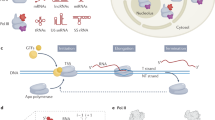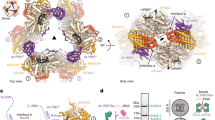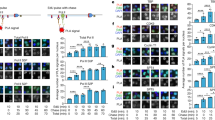Abstract
The specific 3′ termini of a number of eukaryotic mRNAs have been shown to be generated by the post-transcriptional processing of primary transcripts or pre-mRNAs1–4. The sequence AAUAAA, present in the 3′ region of nearly all eukaryotic mRNAs, appears to be involved in the cleavage and subsequent polyadenylation of the primary transcript5. An exception to this general rule is the case of the histone mRNAs, which lack the AAUAAA sequence and are not normally polyadenylated. Histone mRNAs do, however, contain a highly conserved 23 base pair sequence at their 3′ termini6, which is required for correct 3′ end formation7. The similarity between this conserved sequence, which can be drawn as a hairpin loop, and bacterial transcription terminators8 has led several investigators to suggest that the specific 3′ end of histone mRNA is formed by termination of transcription9,10. So far, however, experimental results have not been presented which make it possible to distinguish between a post-transcriptional processing or a transcription termination mechanism for the formation of histone mRNA 3′ termini. We have investigated this issue by synthesizing in vitro unprocessed histone pre-mRNAs that extend past the normal 3′ terminus. These in vitro synthesized pre-mRNAS were injected into frog oocyte nuclei to study their fate. The results demonstrate that correct 3′ ends of chicken histone H2B mRNAs can be formed by RNA processing of longer synthetic pre-mRNAs.
This is a preview of subscription content, access via your institution
Access options
Subscribe to this journal
Receive 51 print issues and online access
$199.00 per year
only $3.90 per issue
Buy this article
- Purchase on Springer Link
- Instant access to full article PDF
Prices may be subject to local taxes which are calculated during checkout
Similar content being viewed by others
References
Ford, J. & Hsu, M. J. Virol. 28, 795–801 (1978).
Nevins, J. R. & Darnell, J. E. Cell 15, 1477–1493 (1978).
Hofer, E. & Darnell, J. E. Cell 23, 585–593 (1981).
Manley, J. L., Sharp, P. A. & Gefter, M. L. J. molec. Biol. 159, 581–589 (1982).
Fitzgerald, M. & Shenk, T. Cell 24, 251–260 (1981).
Hentschel, C. C. & Birnstiel, M. L. Cell 25, 301–313 (1981).
Birchmeier, C., Grosschedl, R. & Birnstiel, M. L. Cell 28, 739–745 (1982).
Pribnow, D. in Biological Regulation and Development Vol. 1 (ed. Goldberger, R. F.) 250–277 (Plenum, New York, 1979).
Busslinger, M., Portmann, R. & Birnstiel, M. L. Nucleic Acids Res. 6, 2997–3008 (1979).
Stunnenberg, H. G. & Birnstiel, M. L. Proc. natn. Acad. Sci. U.S.A. 79, 6201–6204 (1982).
Probst, E., Kressman, A. & Birnstiel, M. L. J. molec. Biol. 135, 709–732 (1979).
Butler, E. & Chamberlin, M. J. biol. Chem. 257, 5772–5778 (1982).
Green, M., Maniatis, T. & Melton, D. Cell 32, 681–694 (1983).
Harvey, R. P., Robins, A. J. & Wells, J. R. E. Nucleic Acids Res. 10, 7851–7863 (1982).
Gurdon, J. & Melton, D. A. A. Rev. Genet. 15, 189–218.
Hentschel, C., Irminger, J., Bucher, P. & Birnstiel, M. L. Nature 285, 147–151 (1980).
Seiler-Tuyns, A. & Birnstiel, M. L. J. molec. Biol. 151, 607–626 (1981).
Zernick, M., Heintz, N., Boime, I. & Roeder, R. G. Cell 22, 807–815 (1980).
Turner, P. & Woodland, H. Nucleic Acids Res. 10, 3769–3780 (1982).
Melton, D., DeRobertis, E. & Cortese, R. Nature 284, 143–148 (1980).
Melton, D. & Cortese, R. Cell 18, 1165–1172 (1979).
Galli, G., Hofstetter, H., Stunnenberg, H. & Birnstiel, M. L. Cell 34, 823–828 (1983).
Author information
Authors and Affiliations
Rights and permissions
About this article
Cite this article
Krieg, P., Melton, D. Formation of the 3′ end of histone mRNA by post-transcriptional processing. Nature 308, 203–206 (1984). https://doi.org/10.1038/308203a0
Received:
Accepted:
Issue Date:
DOI: https://doi.org/10.1038/308203a0
This article is cited by
-
In vitro transcription and translation of a full-length cDNA coding for the human ribosomal protein Lia
Rendiconti Lincei (1993)
-
Transcription of the histone loci on lampbrush chromosomes of the newt Notophthalmus viridescens
Chromosoma (1987)
-
Expression of the c-myb proto-oncogene during cellular proliferation
Nature (1986)
-
Codon usage in histone gene families of higher eukaryotes reflects functional rather than phylogenetic relationships
Journal of Molecular Evolution (1986)
Comments
By submitting a comment you agree to abide by our Terms and Community Guidelines. If you find something abusive or that does not comply with our terms or guidelines please flag it as inappropriate.



